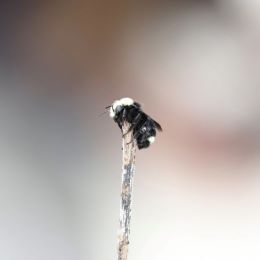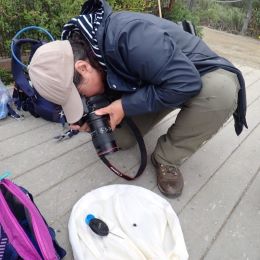CDFW Photo: The Western Section Wildlife Society president Randi McCormick and Atlas staff (Sardinas, Richardson and Winkler) receiving the Conservationist of the Year award at the 2023 conference.

CDFW Photo: Yellow-faced bumble bee.

CDFW Photo: Community science volunteer photographing a chilled bee at an Atlas field training.
The California Bumble Bee Atlas (Atlas), a collaborative community science project developed to track and conserve the state’s native bumble bee species, has been awarded Conservationist of the Year by the Western Section Wildlife Society.
The award, given to a person or group that has made an outstanding contribution to wildlife conservation in California, Nevada, Hawaii or Guam, was presented by the Western Section at its meeting earlier this year.
“It’s an honor for the California Bumble Bee Atlas to be recognized for its contribution to conservation and a testament to the power of community science in addressing critical issues like pollinator decline,” said Hillary Sardiñas, statewide pollinator coordinator for the California Department of Fish and Wildlife (CDFW), and one of the scientists behind the Atlas.
CDFW was awarded funds through the competitive State Wildlife Grant Program to support the Atlas, which is led by CDFW in partnership with The Xerces Society for Invertebrate Conservation (Xerces). CDFW and Xerces staff developed a website to compile resources for volunteers, recruited and trained community scientists from around the state and are using data gathered to help identify priorities for bumble bee conservation in California.
Bumble bees are charismatic and easily recognizable pollinators thanks to their large size and distinctive striped patterns. Bumble bees are predominantly black and yellow but can have red, orange or white coloration. They play an important role in keeping the environment healthy by pollinating flowers in natural areas and contributing to successful harvests on farms.
Recent declines of pollinator populations have drawn attention to their importance in providing ecosystem services, including to over 30% of agricultural crops. In California, eight of the state’s 25 bumble bee species are classified as endangered or vulnerable by the International Union for Conservation of Nature (IUCN).
“Many bumble bee species are in a precarious position due to interacting threats, including habitat loss, climate change and disease spread. The California Bumble Bee Atlas can help track population trends to help identify species and locations for targeted conservation actions,” said Leif Richardson, Atlas lead for Xerces.
To improve understanding of trends in bumble bee populations, Atlas staff train volunteers to collect data without harming bumble bees. Volunteers net bumble bees then chill them to take close-up photos that enable identification. The bumble bees then slowly warm up and fly away. All data and photos are uploaded to the website Bumble Bee Watch, where species are identified by expert taxonomists.
Over 2,000 people have registered for the Atlas as volunteers. These volunteers have conducted thousands of surveys across the state and are the driving force behind the Atlas. Between 2022 and 2023, volunteers and project staff recorded 10,009 bumble bee observations.
“The Atlas wouldn’t be possible without the support of community science volunteers, which have included a number of CDFW staff from around the state. We’re still looking for new volunteers to survey bumble bees and help contribute to this important project,” added Dylan Winkler, CDFW scientific aid for the Atlas.
Going forward, the Atlas will have a new objective: to identify long-term monitoring sites that volunteers visit multiple times a year. This data will provide short- and long-term trends in high-priority locations that support or historically contained California’s bumble bees of greatest conservation need. All data collected from the project will help with the development of a management plan for bumble bees in California, which CDFW and Xerces hope will continue to catalyze conservation of these charismatic and important species throughout the state.
For more information or to get involved, visit the Atlas’ website at cabumblebeeatlas.org.
###
Media Contact:
Amanda McDermott, CDFW Communications, (916) 738-9641